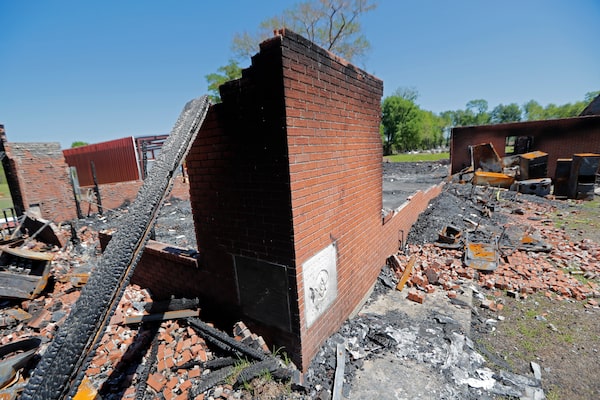
The burnt ruins of the St. Mary Baptist Church, one of three that recently burned down in St. Landry Parish, are seen in Port Barre, La., on April 10, 2019.Gerald Herbert/The Associated Press
Each church catered to an African American congregation. Each graced a rustic, country setting. Each fronted a small cemetery. And each is now a charred disaster scene, the result of three conflagrations that brought echoes of civil rights-era violence to Opelousas, a city of about 16,000 people in rural St. Landry Parish, La.
Thursday brought news of an arrest.
At a news conference, Louisiana Governor John Bel Edwards identified the suspect as Holden Matthews, a 21-year-old white man. He faces three counts of simple arson of a religious building on the state charges, said state Fire Marshal Butch Browning, who added that federal investigators also were looking into whether hate motivated the fires.
St. Landry Sheriff Bobby Guidroz confirmed that Mr. Matthews is the son of a sheriff’s deputy. Sheriff Guidroz said the father knew nothing of his son’s involvement and broke down over the arrest, which he helped facilitate by getting the accused away from home.
Harry Richard – pastor of Greater Union Baptist Church, the site of the second fire – said he’s relieved about the arrest: “This takes a lot of the pressure off us.”
But the Rev. Freddie Jack, of the Seventh District Missionary Baptist Association said, “I would like to know whether he was working alone or not. We can’t let our guard down.”
At the news conference, however, Browning, the fire marshal, expressed confidence that the danger to churches had ended. “This community is safe again,” said Mr. Browning, surrounded by local and federal authorities who had worked on the case. “We are extremely unequivocally confident that we have the person who is responsible for these tragic crimes.”
Governor Edwards said the fires had stirred concern among people around the United States. “It has been especially painful because it reminds us of a very dark past of intimidation and fear,” he said.
A Facebook page that appears to belong to Mr. Matthews shows him with the words “black metal” spray painted on a wall behind him. He also posted a comment on a movie’s portrayal of black metal musician Varg Vikernes, a far-right figure convicted of manslaughter and arson at three churches. Black metal is an extreme sub-genre of heavy metal with lyrics that often espouse Satanism and Paganism. A smaller subset of black metal bands feature neo-Nazi beliefs. The black metal scene was associated with Christian church burnings in Norway in the 1990s.
In the days leading up to the arrest, pastors and parishioners at the churches acted with dismay – and a kind of restraint. “It’s like the sixties again,” said Earnest Hines, a deacon at Mount Pleasant Baptist Church – the site of the third fire.
Yet Mr. Hines, and others connected to the churches, were careful not to automatically label the fires as racist acts.
“I don’t know why this happened, and we don’t need to jump to conclusions,” said Mr. Hines, a member of the church for more than 40 years. “We need to let them investigate, let the evidence come out.” Mr. Jack and Mr. Richard expressed similar sentiments.
The first fire torched the St. Mary Baptist Church in Port Barre last month. Days later, the Greater Union Baptist Church and Mount Pleasant Baptist Church in Opelousas were burned. Each was more than 100 years old.
The churches were empty at the time of the fires, and no one was injured. Investigators with the U.S. Bureau of Alcohol, Tobacco, Firearms and Explosives were still combing the scene at Mount Pleasant and warning away onlookers on Wednesday, a week after the fire.
Investigators had retreated from the ruins of St. Mary Baptist Church in Port Barre, a town just outside of Opelousas and the site of the first fire on March 26. There and at Greater Union, which burned April 2, evidence of the fires’ intensity was more visible. Exterior walls of brick and wood had collapsed on rows of metal folding chairs at Greater Union. All that was left of what looked to have been an upright piano was the lattice-work of steel strings.